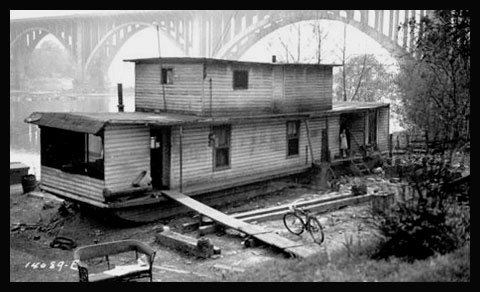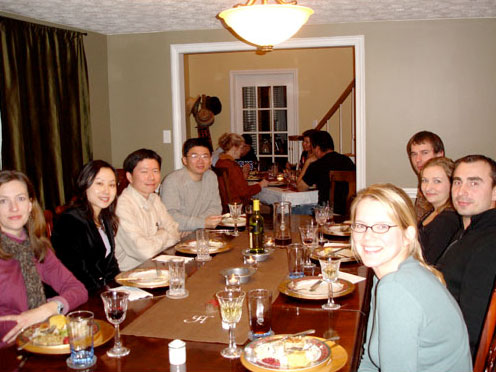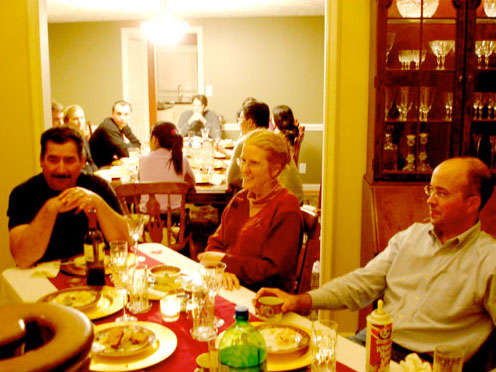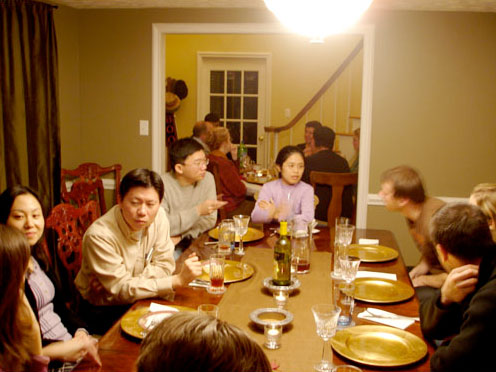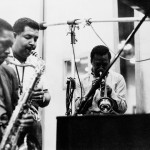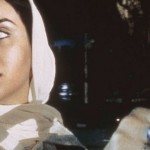Note: Last night I delivered the following talk at the 2004 NEXUS Interdisciplinary Symposium: Reconstructing Theory and Value. I was part of a panel called “Film in the New Millennium,” where I was joined by Paul Harrill, who discussed his short film Brief Encounter with Tibetan Monks; Mark Bernard, who gave a paper on postmodern families in Boogie Nights; and Jeremy Fischer, an actor who introduced us to “The Vertical Process,” a new approach to method acting. As I told the audience last night, I got a bit distracted by the panel title, which is just so fascinating to me and so massive. That’s a subtle way of saying that what my paper lacks in focus, it makes up for in, well, I’m not sure really.
So. To begin. Three brief anecdotes:
Anecdote 1. In 1985, while discussing his latest novel with a French interviewer, Philip Roth lamented the sad state of literary discourse in America. “Talking about movies,” Roth said, “in the relaxed, impressionistic way that movies invite being talked about is not only the unliterate man’s literary life but the literary life of the literate as well.”
Anecdote 2. In September 2002, Iranian filmmaker Abbas Kiarostami was denied entry into the United States. He had planned to accompany his latest film, Ten, to the New York Film Festival and was scheduled afterwards to lecture at Harvard and Ohio State Universities. Ines Aslan, a spokeswoman for the festival’s organizers, recounted their frustrating efforts to reach a compromise with officials at the U.S. Embassy in Paris. “It wasn’t that they could not make an exception,” she said. “It was that they did not choose to.” Kiarostami was understandably bitter. In a letter to the festival’s director, he wrote, “I certainly do not deserve an entry visa any more than the aging mother hoping to visit her children in the U.S. perhaps for the last time in her life…. For my part, I feel this decision is somehow what I deserve.”
Anecdote 3. In November 2003, I walked into my manager’s office, where I discovered her and two other colleagues discussing the ham-handed Christian allegory that, in their unanimous opinion, had ruined both Matrix sequels. I must have sighed or something because one of them turned to me and asked, “What? I thought you were a serious film buff. Don’t you enjoy talking about movies and religion?” The answer, of course, is “yes.” But, as I tried to explain to them that day, The Matrix seems to me to be of limited value for such purposes—a text that seldom elevates discussion above banal, uninformed observations about the “postmodern condition” or something, all of it wrapped in the trappings of anaesthetized ultraviolence. I think I may have even quoted from Baudrillard’s own critique of the film—the one in which he compared watching The Matrix: Revolutions to (and this is a loose translation) “taking a monumental special effect in the rear.”
Two-and-a-half hours later, though, I was still in my manager’s office, and we were all still talking about movies. By that point, I had probably worked through most of my favorite subjects: the problems of “transcendence” in Carl Dreyer’s Ordet, Andrei Tarkovsky’s Orthodox aesthetic of Sculpting in Time, Ingmar Bergman’s agnostic struggle in Winter Light and The Silence, and—since we were on the subject of cinematic Christian allegories—the long-suffering mule in Robert Bresson’s Au Hasard Balthazar. My colleagues, to their credit, were all patient with me. At times, even interested. None fell asleep, at least.
“Film in the New Millennium” must contend, I think, with the issues raised here. Roth may have overstated his case somewhat, but there’s little denying that “talking about movies” is the most significant cultural activity in which the average American participates. New technologies are constantly making that discussion better-informed, while, at the same time, making it also even more superficial and less “literate.” Digital cable and satellite television are pumping hundreds of channels into most homes now, exposing audiences to a wider variety of films and generating new avenues for film distribution; and DVDs, with their commentary tracks and behind-the-scenes and making-of featurettes, are demystifying the filmmaking process.
But when Americans gather to talk about movies, what are they really saying? The terms of this “cultural” discussion are, now more than ever, being defined by those with the greatest economic stake in the health of that discussion. More channels, as we all know, does not necessarily mean that more people are watching more great films; it means that cable bills and advertising revenues are soaring. Those DVD features, more often than not, are crafted by studio marketing departments. Weekend box office returns, for godsake, have become the stuff of CNN’s Headline News. Baudrillard’s interviewer was quick to point out that The Matrix, like Madonna’s latest album, purports to critique a system that, in fact, promoted it aggressively and that benefited directly from its commercial success. “That is indeed what makes our times quite difficult to stand,” Baudrillard replied. “This system produces a trompe-l’œil negation, which in turn is becoming a part of the entertainment industry, . . . Moreover, it is the most efficient way to forbid any true alternative.”
Chalk it up as one more symptom of late capitalism. To bastardize Yeats, it is becoming increasingly difficult to distinguish the dancer from the dance—the film from the massive machine that has generated it. Lord of the Rings is produced at New Line; Elijah Wood is on the cover of Entertainment Weekly; CNN, each half hour, runs the same footage of hobbits and elves lined up for the first midnight viewing; America Online offers exclusive Middle Earth prize packages; DVDs are released twice, in theatrical and then deluxe, extended editions; the film itself might then be broadcast on HBO and, later, TNT; and the whole process takes place under the massive banner of TimeWarner. It’s like that scene in Adaptation, you know, the one where Charlie Kaufman—not the real Charlie Kaufman but the Nicholas Cage Charlie Kaufman—describes himself as a snake eating its own tail. “He’s called Ouroboros, and that’s me,” he says, a nice preemptive and typically ironic stab at our postmodern sensibilities.
And then we have the case of Abbas Kiarostami, long recognized as one of the world’s finest living filmmakers but disallowed from entering America because of his nationality. That his films, in general, but Ten, in particular, espouse the same liberal and humanitarian ideals upon which the Bush administration justified its war with Iraq—if we are to believe the official rhetoric, at least—was apparently inconsequential to those with the authority to grant his visa. At my most cynical, I’m reminded of President Nixon’s response to his old law partner Leonard Garment, who visited the White House to finalize plans for the construction of the Hirshhorn museum of modern art. “I will not have the Mall desecrated with one of those horrible goddamn modern atrocities like they have in New York with that, what is it, that Whitney thing. Jesus H. Christ. . . . I wash my hands of the damn thing. Just make sure I don’t have to see it when I look out this window.”
In a strange way, it’s the same logic that led Laura Bush, in early-2003, to cancel a White House poetry celebration after learning that one of the invited speakers had encouraged his colleagues to use the event as an opportunity to publicly denounce war on Iraq. “It came to the attention of the First Lady’s Office that some invited guests want to turn what is intended to be a literary event into a political forum,” a White House statement said. “While Mrs. Bush understands the right of all Americans to express their political views, this event was designed to celebrate poetry.” The beautiful irony in all this—as many of you, I’m sure, recall—is that the First Lady’s event was to be a celebration of Walt Whitman, Emily Dickinson, and Langston Hughes. I’m still trying to imagine an apolitical reading of, say, Hughes’ “Let America Be America Again”—and not only that, an apolitical reading delivered in the White House.
And so those of us who are particularly motivated—either personally or professionally—to “talk about movies” in this new millennium find ourselves positioned somewhere within what I’ll for now call an “attitudinal triangle.” At one point of the triangle sit those who see movies as just “mindless entertainment.” The majority of Americans live there, I would imagine, and an entire industry has grown up to satisfy their cravings. I would include even the majority of popular film reviewers in that camp. Witness the staff reviewer for our own Knox News-Sentinel, who in any given week rates approximately 80% of all current releases with at least 3 ½ stars on her 5-star scale. The public critic as arbiter of taste and thoughtful, informed educator has been replaced by a voice that too often simply reinforces existing attitudes—much to TimeWarner’s delight, I might add. (Remember Ouroboros?)
At another point of the triangle sit a dwindling number who would still seek art for art’s sake alone. They are, at times, a reactionary lot, arguing like Mrs. Bush for a “celebration” of beauty or form or individual genius or patriotism or dignity divorced completely from the messy details of democracy or commerce or justice. As an aside: That those last three terms—democracy, commerce, and justice—have become inextricably bound to one another in our post-Cold War world is perhaps the messiest detail of all.
And finally, at the third point of the triangle sit those, like many of us here today, who have systematically honed their skills as critics and readers and lovers of art during the late-20th century. With political motivations of our own—let’s admit it—and armed with continental philosophy—or, in my case at least, with water-down, superficial understandings of continental philosophy—we champion the “text as politics,” flaying its lifeless flesh for the symptoms of exploitation. Like the popular “thumbs up, thumbs down” film reviewer, many in this camp are reluctant to draw firm conclusions based on purely aesthetic criteria, arguing instead for a kind of implicit relativism. Ideology, they would argue, flattens the curve, giving equal legitimacy to a Pynchon novel, a Budweiser advertisement, and an episode of Seventh Heaven. I like Ishmael Reed’s line from his novel, The Terrible Threes: “There were still galleries in which art hung that was less interesting than the jargon that was peddled in its behalf” (Threes, 152).
These are all gross reductions and oversimplifications, of course, but that is partly my point. None of us exists wholly at any of these extremes; we move, instead, with some fluidity between them. Which brings me back, finally, to that third anecdote—the marathon film and religion discussion that took place over in Dunford Hall. What happened there that day has come to represent something of a model for me of what it means to really talk about movies. It forced each of us to swing, uncomfortably at times, between the points of that attitudinal triangle. It was spoken in a personal, patient voice, valuing relationships and opinions, shared and unpopular ones alike. It was heated and enthusiastic and highly-charged but still humble, self-deprecating even. It was historically-informed—I did my best to proselytize for the European masters and to speak to issues of film form—and it was culturally- and politically-engaged. Perhaps most refreshing of all, though—especially given the larger context of this NEXUS symposium—is that it forced even the most skeptical of us to recognize the legitimacy, the necessity even, of acknowledging religious experience (for lack of a better word) as a shaper of our encounters with culture.
And, so now, the good news. One last anecdote. In preparation for this panel I searched through my issues of Film Comment that were published over the past four years, jotting down the titles of films that had worked their way onto critics’ year-end “best” lists but that I had been unable to see. I then forwarded a portion of that list on to a few members of a film discussion email listserv in which I have participated for a number of years. By the end of the week, packages were arriving at my door, each containing perfect digital copies of DVDs that have yet to be released in America: films by Bela Tarr, Bruno Dumont, Shohei Imamura, Kiyoshi Kurosawa, Olivier Assayas, Hou Hsiao-Hsien. And on and on. This is how I was finally able to see Kiarostami’s Ten, in fact. My friends had ripped DVD-Rs on their computers in Toronto or London or wherever, and I watched them all on my Malata region-free DVD player—an inexpensive machine that circumvents the region-coding that prevents most players from properly displaying discs manufactured in other countries. So there I sat, in the cultural wilds of East Tennessee, watching these remarkable films, and all it cost me was the kind generosity of a few friends (whom I’ve never met face to face) and the price of a couple blank DVDs. Take that, TimeWarner.
Film in the New Millennium—like communication in the new millennium and politics in the new millennium and education and community and democracy in the new millennium—will be experienced increasingly via purely digital, anational forms. There’s nothing new to that idea—nothing that hasn’t been said already a hundred times in each new issue of Wired. The less obvious lesson to be learned from this anecdote, though, is that the historically-informed, socially- and politically-engaged, and passionate, fan-boy film discussions that I called for earlier are already taking place, but they too seldom occur in the pages of, say, Literature Film Quarterly. Or in the pages of anything, for that matter.
Acquarello, a NASA aerospace engineer, posts weekly capsule reviews of foreign and art films on his Website, Strictly Film School. Its traffic numbers in the tens of thousands, and Wellspring Home Video now often includes a link to his site as an “extra” on their foreign film DVD releases. When producers from the Criterion Collection began compiling sources for their recent releases of The Killers and Diary of a Country Priest, two of their first contacts were Trond Trondson, a geophysicist in Calgary, and Doug Cummings, a graphic artist in Los Angeles, who operate sites dedicated to Tarkovsky and Bresson. (I know this because I regularly exchange emails with Pascal, Trond, and Doug.) Culture bloggers, many of them former and current academics, are forsaking traditional modes of academic publication for the more immediate and, dare I say it, rewarding experience of online publishing. And, in an example that hits a bit closer to home, Paul and I are both contributors to Senses of Cinema, a quarterly, partially-refereed online journal associated with the Australian Film Commission. As an ABD soon to be hitting the job market, I’m painfully aware of how utterly irrelevant those lines on my C.V. will be to most hiring committees. But that also will change in this new millennium. And I can’t wait to watch it happen.
